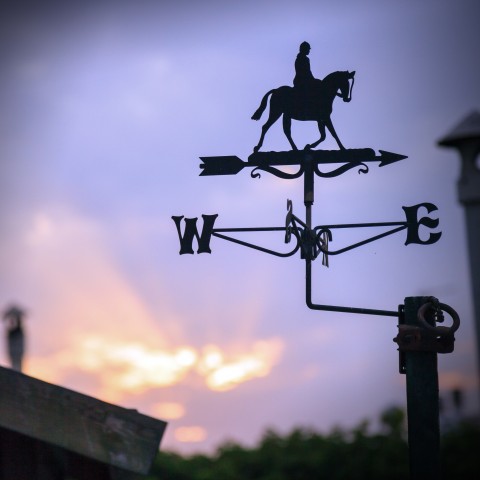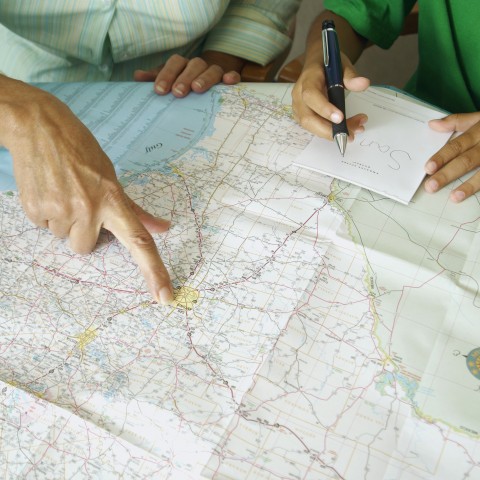
Being outside in Romania is great—except when you’re lost.
Wouldn’t it be great if you could ask somebody for help? Or even just ask where the McDonald’s is?
That, of course, is the obvious benefit of knowing how to talk about directions in Romanian. (Not the McDonald’s part, the not-getting-lost part.)
Did you know, though, that mastering directions in Romanian can level-up your whole command of the language? Think about it: you’ve got new vocabulary, new sentence patterns, and even new conversation starters, just from one topic.
How much do you know already about directions in Romanian?
 Table of Contents
Table of Contents
- Basic Cultural Notes and Phrases
- Learn the Romanian Compass Points
- City Vocabulary and Reference Points
- Phrases for Directions in Romanian, Part 1: Asking Others
- Part 2: Giving Directions in Romanian
- Travel Time
- Directions Can Lead You to a Wealth of Language Practice
- Conclusion
1. Basic Cultural Notes and Phrases
A lot of Romanians are quite good at English, and they’re all very polite and friendly. If you ask for directions in English, you’re likely to be understood by young people in any city.
However, if you can show them that you’ve put some real effort into your Romanian (that means having correct pronunciation), then they’ll be impressed and quite happy not to switch to English on you.
To politely get somebody’s attention on the street, simply say:
- Scuzați-mă!
Excuse me!
Or maybe:
- Mă puteți ajuta?
Could you help me?
These two phrases will help you lead into actually asking them for directions, which we’ll cover in a little while.
Romanian towns and cities are old, and people usually grew up on the same streets that are there now. During the various changes in government in the twentieth century, though, many street names did change in Romania to honor political figures.
Therefore, older people and younger people may remember streets by different names. If you can’t find a certain street that you heard mentioned, you can ask someone like this:
- Scuzați-mă, unde e strada asta?
Excuse me, where is this street?
2. Learn the Romanian Compass Points

If you happen to have studied any German in the past, these compass points in Romanian are going to seem very familiar to you.
| English | Romanian |
|---|---|
| north | nord |
| south | sud |
| east | est |
| west | vest |
| northwest | nord-vest |
| northeast | nord-est |
| southwest | sud-vest |
| southeast | sud-est |
Nord-Vest, Nord-Est, Sud-Est, Sud-Vest, and Vest are all also names of development regions of Romania, by the way. They’re not often used in daily conversation, but if you read any articles about Romania, particularly its economy, you may be confused by this.
To make it clear, it’s better to be specific about the fact that you’re talking about the parts of a country or city. This is done in two ways: using the phrase partea de and a cardinal direction, or using the adjective form of that direction.
- Este în partea de vest a UE.
It’s in the western part of the EU.
- E din partea sudică a Albei.
It’s from the southern part of Alba.
In addition to these absolute directions, you’ll also need to know four very useful relative directions for talking to drivers, and really just describing things in general.
| English | Romanian |
|---|---|
| left | stânga |
| right | dreapta |
| forward | înainte |
| back | înapoi |
When you talk about turning, you’ll need to add la in front of the direction to speak grammatically correct. Take a look at this example now, and we’ve got more coming up.
- După intersecție, ia-o la stânga.
At the intersection, turn left.
3. City Vocabulary and Reference Points

Now we come to the actual studying: the vocabulary. You simply can’t speak accurately about Romanian cities without having a good set of words and phrases. In this section, we’ll give you helpful phrases that you can use to practice prepositions as well. Remember, it’s always good to learn a language in chunks!
centru — city center
- Restaurantul este situat în centrul oraşului.
The restaurant is located in the city center.
cartier de afaceri — business district
- Suntem în mijlocul unui cartier de afaceri.
We’re in the middle of a business district.
marginea orașului — the edge of town
- Locuiește la marginea orașului.
She lives on the edge of town.
centru comercial — shopping center
- De ce ești în spatele unui centru comercial?
Why are you behind a shopping center?
Make sure that you not only have these words memorized, but you also know how to talk about the basics, like landmarks and streets. Cities in Romania tend to have an abundance of statues and churches, so these are good words to know as well.
statuie — statue
- Ne întâlnim la hotel de lângă statuie.
We’ll meet in the hotel next to the statue.
piață — square
- Este o biserică drăguță în piața orașului.
There’s a pretty church in the town square.
stradă — street
- Te uiți în ambele părți când traversezi strada.
Look both ways when you cross the street.
semafor — traffic light / traffic signal
- Fă dreapta la semafor.
Turn right at the traffic light.
oficiu poștal — post office
- Magazinul de bijuterii este chiar lângă oficiul poștal.
The jewelry store is right next to the post office.
bancă — bank
- Nu se află nimic în apropierea băncii.
It’s nowhere near the bank.
biserică — church
- În spatele acelor copaci este o biserică mică.
Behind those trees is a little church.
4. Phrases for Directions in Romanian, Part 1: Asking Others

Two words in Romanian, and you’re most of the way there to asking people for directions: unde este. This literally means “where is,” and you can make hundreds of sentences with these words alone.
I just said that there were only two words, but you’ve doubtlessly also seen unde e, meaning the same thing. What gives?
Actually, nothing. In Romanian, the verb a fi, or “to be,” has a short form (e) and a long form (este). Este is simply considered more formal than e alone.
- Unde e biblioteca?
Where is the library?
- Scuză-mă, dar unde e oficiul poștal?
Excuse me, but where is the post office?
This is good, but you should also be aware that it implies the definite existence of a library or post office. If there’s no library or post office in that area of town, it might be confusing for everybody involved.
That’s why you can also use this sentence pattern:
- E vreun restaurant prin apropiere?
Is there a restaurant nearby?
- E vreun hotel pe aici?
Is there a hotel around here?
Vreun actually means “some” or “any”—the root verb is simply a fi meaning “to be.” However, vreun is only singular, making it a little awkward to try and translate directly into English.
You can also ask about what you’d like to do, and hopefully somebody nearby knows where you can accomplish that task.
- De unde pot cumpăra ceva de băut?
Where can I get something to drink?
- De unde pot lua niște apă, vă rog?
Where can I get some water, please?
5. Part 2: Giving Directions in Romanian

The longer you live or travel in a foreign country, the more your body language will show that you’re comfortable there. At some point, locals may ask you for directions! Let me tell you, that’s a wonderful feeling, and even better when you can give them the correct answer quickly and easily in Romanian.
Of course, these are also phrases that you might get as answers to the questions we went over in the previous section, but it’s a lot more fun to pretend that you’re the expert in Romania.
You should first give them a general idea of the distance they’re dealing with.
- Este foarte aproape.
It’s very close by.
Or:
- Este departe. Doi, poate trei kilometri.
It’s far away. Two, maybe three kilometers.
This will at least give them a ballpark of what to expect.
You should know that there are two ways to tell someone “to turn” in Romanian: luați-o and faceți. There’s no difference, but you’ll probably hear both of them if you travel through the country.
Here are some more phrases you can use:
- Nu este pe strada asta.
It’s not on this street.
- Trebuie să mergeți pe această stradă și apoi faceți la dreapta.
You need to go down this road and then turn right.
- După 100 de metri, faceți la stânga.
After 100 meters, turn left.
- La semafor, faceți la dreapta.
Turn right at the traffic light.
One very important word for you to know is înainte, which means “straight” or “straight ahead.” If you’ve forgotten all else, you can guide a taxi by simply pointing and saying înainte! over and over until you arrive at your destination.
This kind of “Tarzan Romanian,” by the way, can get you far if your mind goes blank and you can’t remember any of your verbs. In a pinch, you can point at a map and say Unde? and it still counts as Romanian practice!
6. Travel Time

Now, a quick section on travel time. This isn’t directions specifically, but it’s used to add extra detail to your question or answer, and really start to stretch your abilities. It’s also very useful information!
Romanians usually get around with buses, taxis, or even by hitching a ride from passing drivers. Therefore, if you’re traveling by foot, they might not be sure about how long it really takes to get to a certain place.
For that reason, it’s a good idea to ask questions like the ones below that can help you get a better idea of the time investment you’re putting in.
- Este departe?
Is it far?
- Cât timp fac dacă merg pe jos?
How long does it take to walk?
- Cât de departe este Piața Victoriei?
How far is Victory Square?
And the answers could be anything. For example:
- E la 5 minute de mers pe jos.
It’s a five-minute walk.
- Poate dura o oră sau mai mult.
It could take an hour or more.
7. Directions Can Lead You to a Wealth of Language Practice

Whether you’re taking a taxi or hitchhiking, you’ll probably come to a point in your travels when you have the chance to speak to a driver. Obviously, this is a great opportunity to practice your Romanian, but it’s super-easy to be lost for words here.
It turns out that one of the best things you can talk about is how much the city has changed.
Anybody loves talking about the changes in their hometown, and with as much change as Romania has gone through in the last few decades, you’re never going to run out of topics to discuss.
You can start with something like this:
- Cum s-a schimbat orașul de-a lungul anilor?
How has the city changed over the years?
- S-a schimbat foarte mult?
Has it changed a lot?
You don’t need to rely on drivers, either. Ordinary people and business owners likely have a lot to say on the topic, too.
- Ce era aici înainte să faceți hotelul?
What was here before you built the hotel?
They’ll give you plenty of opportunity to practice what you’ve learned so far.
And perhaps talking about past changes seems a little intimidating for your level of Romanian. Not a problem—we can still start conversations with others in an easy way.
All you have to do is ask for directions to places that you already know. Go right out of your hotel and go to a grocery store, and ask how to get to your hotel. They don’t know where you came from! Since you already know the way, you’ll be able to understand more easily.
Then another day, ask at your hotel about how to get to that grocery store! The repetition over multiple days, plus the different approaches to the same topic, will absolutely help you get the material in your memory.
8. Conclusion
What should you do if you’re not in Romania yet?
You’re already doing one of the best things—visiting RomanianPod101.com and reading through the lessons and articles right here.
Another super-easy way to practice directions is to go to Google Maps and switch the interface language to Romanian in the settings. Try this on an incognito tab if you’re worried you won’t be able to change it back afterward.
Challenge yourself, as well. Ask yourself where things are in your own town and see if you can answer in Romanian.
The more you work on this material, the easier it will be to bring to mind when you need it—and the slower it will fade over time.
Do you still have questions about directions in Romanian, or are things pretty crystal-clear? Feel free to drop us a comment with any questions or concerns you have on this topic! We look forward to hearing from you.
Happy Romanian learning!










